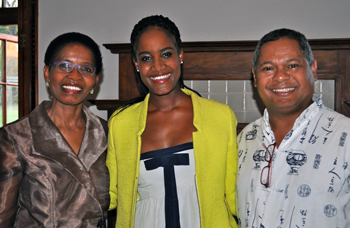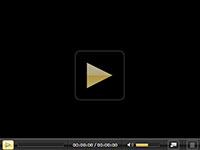
From the left are: Prof Pumla Gobodo-Madikizela, Candice Mama and Prof André Keet, Director of the UFS Institute for Reconciliation and Social Justice.
Photo: O'Ryan Heideman |

Candice Mama: Audio
Candice Mama and her family met with her father’s assassin. Eugene de Kock. Prime Evil. Commander of the apartheid government’s covert Vlakplaas police unit. And what followed from this meeting was one of our country’s most poignant gestures of reconciliation. One by one, each family member expressed their forgiveness of De Kock, and soon afterwards, he was granted parole.
Candice recently visited the Bloemfontein Campus to talk about ‘An Unexpected Encounter with Eugene de Kock: A Journey of Transformation’. The event was a collaborative effort between the Institute for Reconciliation and Social Justice and Trauma, Forgiveness, and Reconciliation Studies.
“What makes it possible to cross the boundary from loss and pain to bond with the person who hurt you?” Prof Pumla Gobodo-Madikizela, asked Candice. “I had to educate myself about the when, where, and how, to get a context for Eugene de Kock,” she answered. With the encouragement of her mother, Candice became an avid reader from an early age. She devoured information, so that she could build a picture of this man within a specific historical and political context. What also contributed to this moment of reconciliation for her was De Kock humbling himself and taking full responsibility for his actions.
This meeting was not without inner conflict for Candice, though. “Why am I crying for hím?” she asked herself as she listened to him speak. “Why am I laughing?” she chastised herself as De Kock preened shyly for a group photograph with the family. “Is there something wrong with me to connect with him?” She questioned her values and beliefs. But instead of a monster, Candice saw the true essence of a repentant human being.
But how do you know he didn’t fake it, many people asked. Because it was “one of the most sincere and honest encounters I’ve experienced,” she said. During their meeting, Candice saw a man “crushed by the world”. Everything he believed as a young man, he realised, was a lie.
“Do you forgive yourself?” Candice asked the one question De Kock feared most. And in that moment, he was humanised for her. “When you’ve done the things I’ve done,” De Kock replied, “how do you forgive yourself?”
It remains an open question. But this act of forgiveness gives an entire country hope.
For more information or enquiries contact news@ufs.ac.za.